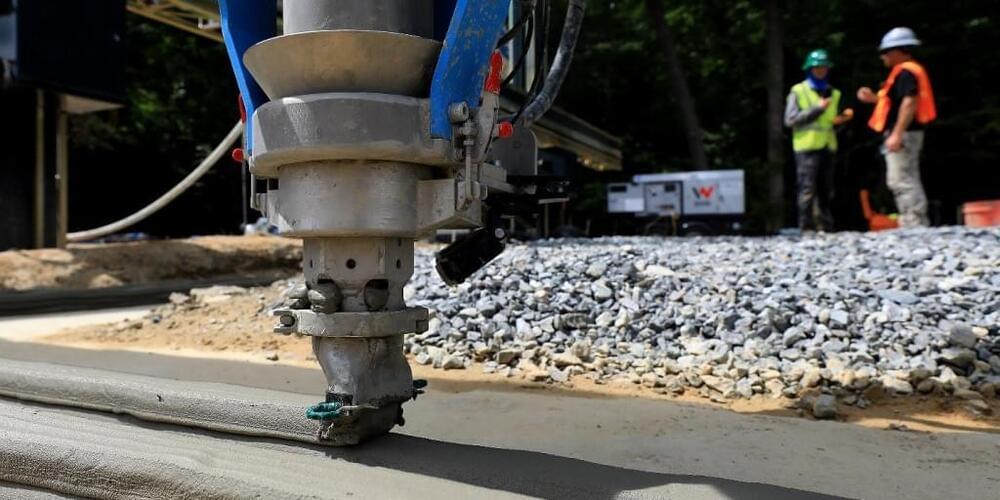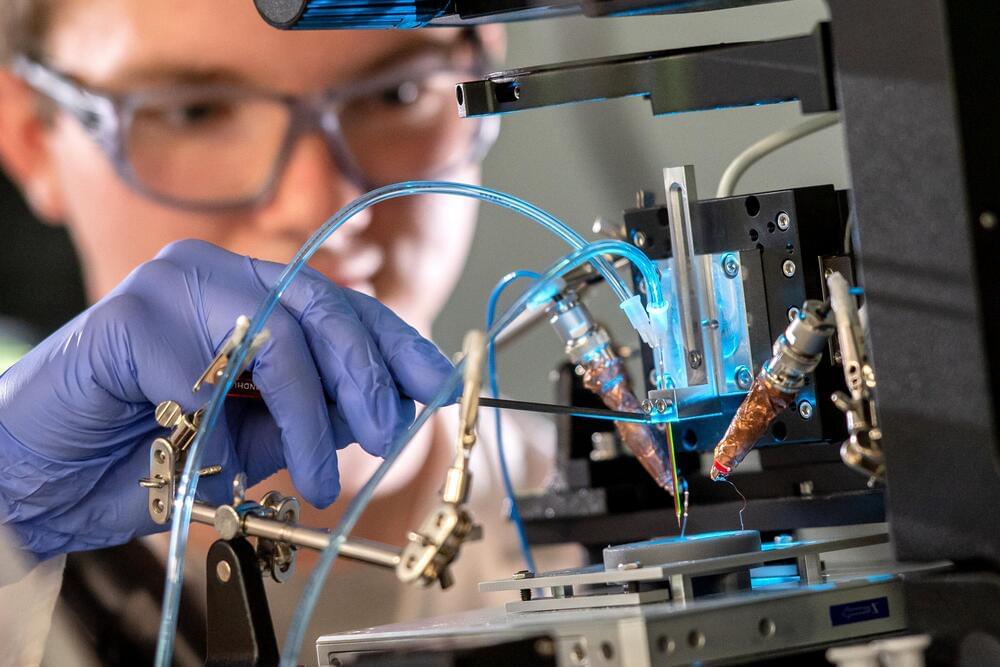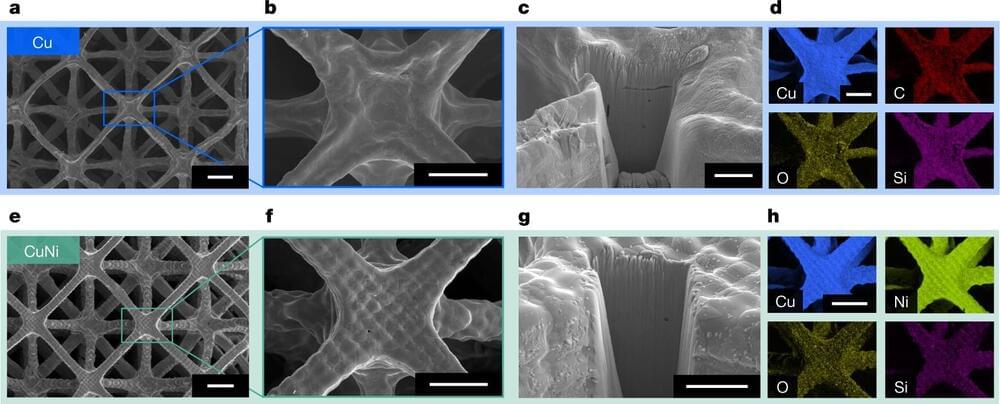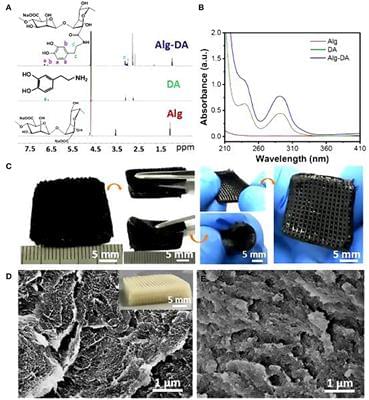3D printing machines can build up to 40 percent of homes during the construction process and save money on labor costs, experts say.



It takes chemist Liaisan Khasanova less than a minute to turn an ordinary silica glass tube into a printing nozzle for a very special 3D printer. The chemist inserts the capillary tube—which is just one millimeter thick—into a blue device, closes the flap and presses a button. After a few seconds there is a loud bang and the nozzle is ready for use.
“A laser beam inside the device heats up the tube and pulls it apart. Then we suddenly increase the tensile force so that the glass breaks in the middle and a very sharp tip forms,” explains Khasanova, who is working on her Ph.D. in chemistry in the Electrochemical Nanotechnology Group at the University of Oldenburg, Germany.
Khasanova and her colleagues need the minuscule nozzles to print incredibly tiny three-dimensional metallic structures. This means the nozzles’ openings must be equally tiny—in some cases so small that only a single molecule can squeeze through. “We are trying to take 3D printing to its technological limits,” says Dr. Dmitry Momotenko, who leads the junior research group at the Institute of Chemistry. His goal: “We want to assemble objects atom by atom.”

In addition to laser-assisted bioprinting, other light-based 3D bioprinting techniques include digital light processing (DLP) and two-photon polymerization (TPP)-based 3D bioprinting. DLP uses a digital micro-mirror device to project a patterned mask of ultraviolet (UV)/visible range light onto a polymer solution, which in turn results in photopolymerization of the polymer in contact [56, 57]. DLP can achieve high resolution with rapid printing speed regardless of the layer’s complexity and area. In this method of 3D bioprinting, the dynamics of the polymerization can be regulated by modulating the power of the light source, the printing rate, and the type and concentrations of the photoinitiators used. TPP, on the other hand, utilizes a focused near-infrared femtosecond laser of wavelength 800 nm to induce polymerization of the monomer solution [56]. TPP can provide a very high resolution beyond the light diffraction limit since two-photon absorption only happens in the center region of the laser focal spot where the energy is above the threshold to trigger two-photon absorption [56].
The recent development of the integrated tissue and organ printer (ITOP) by our group allows for bioprinting of human scale tissues of any shape [45]. The ITOP facilitates bioprinting with very high precision; it has a resolution of 50 μm for cells and 2 μm for scaffolding materials. This enables recapitulation of heterocellular tissue biology and allows for fabrication of functional tissues. The ITOP is configured to deliver the bioink within a stronger water-soluble gel, Pluronic F-127, that helps the printed cells to maintain their shape during the printing process. Thereafter, the Pluronic F-127 scaffolding is simply washed away from the bioprinted tissue. To ensure adequate oxygen diffusion into the bioprinted tissue, microchannels are created with the biodegradable polymer, polycaprolactone (PCL). Stable human-scale ear cartilage, bone, and skeletal muscle structures were printed with the ITOP, which when implanted in animal models, matured into functional tissue and developed a network of blood vessels and nerves [45]. In addition to the use of materials such as Pluronic F-127 and PCL for support scaffolds, other strategies for improving structural integrity of the 3D bioprinted constructs include the use of suitable thickening agents such as hydroxyapatite particles, nanocellulose, and Xanthan and gellan gum. Further, the use of hydrogel mixtures instead of a single hydrogel is a helpful strategy. For example, the use of gelatin-methacrylamide (GelMA)/hyaluronic acid (HA) mixture instead of GelMA alone shows enhanced printability since HA improves the viscosity of mixture while crosslinking of GelMA retains post-printing structural integrity [58].
To date, several studies have investigated skin bioprinting as a novel approach to reconstruct functional skin tissue [44, 59,60,61,62,63,64,65,66,67]. Some of the advantages of fabrication of skin constructs using bioprinting compared to other conventional tissue engineering strategies are the automation and standardization for clinical application and precision in deposition of cells. Although conventional tissue engineering strategies (i.e., culturing cells on a scaffold and maturation in a bioreactor) might currently achieve similar results to bioprinting, there are still many aspects that require improvements in the production process of the skin, including the long production times to obtain large surfaces required to cover the entire burn wounds [67]. There are two different approaches to skin bioprinting: in situ bioprinting and in vitro bioprinting. Both these approaches are similar except for the site of printing and tissue maturation. In situ bioprinting involves direct printing of pre-cultured cells onto the site of injury for wound closure allowing for skin maturation at the wound site. The use of in situ bioprinting for burn wound reconstruction provides several advantages, including precise deposition of cells on the wound, elimination of the need for expensive and time-consuming in vitro differentiation, and the need for multiple surgeries [68]. In the case of in vitro bioprinting, printing is done in vitro and the bioprinted skin is allowed to mature in a bioreactor, after which it is transplanted to the wound site. Our group is working on developing approaches for in situ bioprinting [69]. An inkjet-based bioprinting system was developed to print primary human keratinocytes and fibroblasts on dorsal full-thickness (3 cm × 2.5 cm) wounds in athymic nude mice. First, fibroblasts (1.0 × 105 cells/cm2) incorporated into fibrinogen/collagen hydrogels were printed on the wounds, followed by a layer of keratinocytes (1.0 × 107 cells/cm2) above the fibroblast layer [69]. Complete re-epithelialization was achieved in these relatively large wounds after 8 weeks. This bioprinting system involves the use of a novel cartridge-based delivery system for deposition of cells at the site of injury. A laser scanner scans the wound and creates a map of the missing skin, and fibroblasts and keratinocytes are printed directly on to this area. These cells then form the dermis and epidermis, respectively. This was further validated in a pig wound model, wherein larger wounds (10 cm × 10 cm) were treated by printing a layer of fibroblasts followed by keratinocytes (10 million cells each) [69]. Wound healing and complete re-epithelialization were observed by 8 weeks. This pivotal work shows the potential of using in situ bioprinting approaches for wound healing and skin regeneration. Clinical studies are currently in progress with this in situ bioprinting system. In another study, amniotic fluid-derived stem cells (AFSCs) were bioprinted directly onto full-thickness dorsal skin wounds (2 cm × 2 cm) of nu/nu mice using a pressure-driven, computer-controlled bioprinting device [44]. AFSCs and bone marrow-derived mesenchymal stem cells were suspended in fibrin-collagen gel, mixed with thrombin solution (a crosslinking agent), and then printed onto the wound site. Two layers of fibrin-collagen gel and thrombin were printed on the wounds. Bioprinting enabled effective wound closure and re-epithelialization likely through a growth factor-mediated mechanism by the stem cells. These studies indicate the potential of using in situ bioprinting for treatment of large wounds and burns.
Thanks, Pinecone, for sponsoring this video! Click my exclusive link https://www.influencerlink.org/SHEQZ to start earning cash on Pinecone!Last Video: How We Will Build An Underground Civilization On Mars!
https://www.youtube.com/watch?v=BjJfc0mGAp8►
Join Our Discord Server: https://discord.gg/zfMNSnuRQN
► Patreon: https://www.patreon.com/theteslaspace.
► Subscribe to our other channel, The Space Race: https://www.youtube.com/c/TheTeslaSpace.
Mars Colonization News and Updates.
https://www.youtube.com/playlist?list=PLBfN0491sF0SQRy0-pZBjdnBaU6JsWr4BSpaceX
News and Updates: https://www.youtube.com/playlist?list=PLBfN0491sF0QGbrNimSIWKYeyQ7JjENhEThe Space Race is dedicated to the exploration of outer space and humans’ mission to explore the universe. We’ll provide news and updates from everything in space, including the SpaceX and NASA mission to colonize Mars and the Moon. We’ll focus on news and updates from SpaceX, NASA, Starlink, Blue Origin, The James Webb Space Telescope and more. If you’re interested in space exploration, Mars colonization, and everything to do with space travel and the space race… you’ve come to the right channel! We love space and hope to inspire others to learn more! ► Subscribe to The Tesla Space newsletter: https://www.theteslaspace.comBusiness Email: [email protected]#SpaceX #Space #Mars

“Our goals were to explore the new sound world created by using new materials”
Only musicians can understand how grueling and challenging it is to play the violin. Violins, even mediocre ones, are worth thousands of dollars. Good news for music students and beginners, they will meet with low-cost and durable 3D-printed violins thanks to The Acoustical Society of America’s AVIVA Young Artists Program.
As stated in the release, today in Nashville, Mary-Elizabeth Brown, director of the AVIVA Young Artists Program discussed the steps taken and the lessons learned in her presentation, Old meets new: 3D printing and the art of violin-making.
Shawn Peters.
The team’s inspiration roots in multiple places, said Brown. Our goals were to explore the new sound world created by using new materials, to leverage the new technology being used in other disciplines, and to make music education sustainable and accessible through the printing of more durable instruments.

Engineers at Caltech have developed a method for 3D printing pure and multicomponent metals, at a resolution that is, in some cases, an order of magnitude smaller than previously possible. The process, which uses water-based chemistry and 3D printing, was described in a paper published in Nature on October 20.

Construction and 3D Printing. This is a really cool video. There is demand for affordable housing, and it can be built and rented out, or just lived in. Imagine if many people where you live are empowered with simple housing. Would it be a waste of money if it can pay for itself?
This is the cool company that makes these cool machines. The USA sent $1 billions in weapons to Ukraine in one month, to a war that costs $1 billion a month. Elon Musk just paid $44 billion for Twitter when a $50 billion investment in affordable housing could net him how much in rental income if the houses cost $15,000 in materials?
Mudbots demo house in their facility built to demonstrate the operation of the printer and installation of many parts which would also be included within a real home.
Submit a project I should feature!
Volumetric 3D printing is an exciting technology that could lead to extremely rapid production of 3D printed parts by curing every particle of the object at once. Now, researchers from Utrecht University are applying the process to bioprinting and have 3D printed functioning liver units at centimeter scale in less than 20 seconds. The results were published in Advanced Materials.

Circa 2021:3
Surgical management of breast cancer often results in the absence of the breast. However, existing breast reconstruction methods may not meet the need for a replacement tissue. Tissue engineering with the use of emerging materials offers the promise of generating appropriate replacements. Three-dimensional (3D) printing technology has seen a significantly increased interest and application in medically-related fields in the recent years. This has been especially true in complex medical situations particularly when abnormal or complicated anatomical surgical considerations or precise reconstructive procedures are contemplated. In addition, 3D bio-printing which combines cells with bio-material scaffolds offers an exciting technology with significant applications in the field of tissue engineering. The purpose of this manuscript was to review a number of studies in which 3D printing technology has been used in breast reconstructive surgical procedures, and future directions and applications of 3D bio-printing.
Breast cancer is the most common cancer diagnosed among US women and is second only to lung cancer as a cause of cancer death among women as of 2019. Because ~268,600 (almost six times than DCIS) new cases prove to be an invasive type of breast cancer (1), many women had to choose the removal of the breast, with immediate consideration for a replacement tissue. Although this was satisfactory in many patients, either saline or gel-filled breast implants (2) do carry real risks of complications such as infection, capsular contracture, implant dislocation, or deformities (3, 4). The option of autologous reconstruction can be more texturally natural aesthetically, but it requires a more complex procedure, significant time and expense, and possible muscle weakness or hernia formation at the tissue donor site (5). Tissue engineering intends to address these limitations by combining the 3D printing technology with synthetic or natural structural elements.
Three-dimensional (3D) printing, also known as computer-aided manufacturing (CAM), was based on digital model files using metal powder or plastic and other adhesive materials to construct objects with a computer guided precision, printing layer upon layer. Simplistically, it uses a computer aided design (CAD) program to convert the virtual model of an object into a printable object using an STL (Standard Tessellation Language or STereoLithography) file. The object then gradually and precisely takes shape as each thin layer is added according to the design file, and composed of the desired material for that object in the form of “ink” using the 3D printer. Not only in cases of intraoperative 3D printed models serving as templates, but this technology has extended to implanted scaffolds that have been used to correct defect-specific sites, clearly enhancing patient treatment (6, 7).